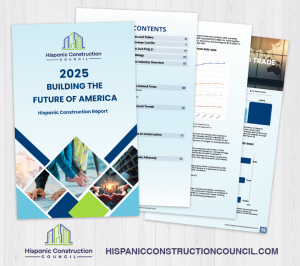For generations, Hispanic workers have been the unsung heroes, the unwavering driving force behind the U.S. construction industry.”
WASHINGTON, DC, UNITED STATES, April 23, 2025 /EINPresswire.com/ -- The Hispanic Construction Council (HCC) today released its landmark publication, BUILDING THE FUTURE OF AMERICA: 2025 Hispanic Construction Report, a comprehensive analysis of the current challenges and future trajectory of the U.S. construction industry. The report underscores the urgent need for coordinated action as the sector grapples with severe labor shortages, rising costs due to tariffs, and policy-driven uncertainty in immigration and workforce access.— George Carrillo, CEO of the Hispanic Construction Council (HCC)
The U.S. construction industry remains a vital part of the national economy, generating $2.5 trillion annually and driving progress in infrastructure, housing, and economic development across the country. However, the industry faces significant challenges, with a severe labor shortage being one of the most pressing. Currently there are over 500,000 job openings, and this figure is projected to surpass one million by 2030. Initiatives such as the Infrastructure Investment and Jobs Act have increased the demand for skilled professionals, including electricians, carpenters, and construction managers. Yet, meeting this demand is proving difficult due to an aging workforce and the limited availability of trained workers. Additionally, the annual cap of 66,000 H-2B visas, fully allocated for 2025, is insufficient to support the industry’s growing workforce needs, further intensifying the labor shortage crisis.
Hispanic workers and business owners are indispensable to the construction industry's current and future stability. Hispanic-owned construction firms now number over 95,000, collectively generating $779 billion in annual revenue and employing nearly 4 million workers. In 2023, Hispanic workers made up 33.8 % of the industry’s workforce, a share expected to increase to 35.2 % by 2025 (4.3 million), potentially reaching half of the workforce by 2030. These workers and business owners fuel innovation, foster economic mobility, and contribute significantly to local development efforts nationwide. Investing in the advancement of Hispanic workers and firms can unlock substantial gains in productivity, cost-efficiency, and wealth creation across the construction and real estate sectors.
“For generations, Hispanic workers have been the unsung heroes, the unwavering driving force behind the U.S. construction industry,” said George Carrillo, CEO of the HCC. “Their tireless dedication, skill, and resilience have fueled its remarkable growth and shaped the skylines of our nation. Today, with immense pride, we present the Hispanic Construction Annual Report: a testament to our community's invaluable contributions and a resounding call to action for achieving lasting progress and equity within the sector.”
Even as Hispanic workers and firms contribute significantly, they continue to face challenges that hinder their potential. Unsafe working conditions and wage inequalities remain concerning issues, with Hispanic workers accounting for 27% of construction-related fatalities and earning 20 to 30% less than their non-Hispanic counterparts. Hispanic-owned construction firms face additional barriers, such as limited access to capital and complex certification processes, which restrict their ability to scale operations and secure public contracts. If these disparities are not addressed, they will continue to limit opportunities for growth, stifling both innovation and economic potential within the construction sector.
Geopolitical and economic pressures are adding new layers of difficulty to these existing challenges. Recent tariffs imposed on steel, aluminum, and construction equipment are pushing project costs higher, with some home prices increasing by $17,000 to $22,000. These cost hikes threaten affordability, delay infrastructure projects, and create additional strain for small and minority-owned firms. The potential for large-scale deportations of undocumented workers could remove as many as 900,000 essential employees from the construction workforce, further declining workforce shortages to 1.3 million by 2030. Leading to project delays, labor shortages, and reduced national productivity. Against the backdrop of rising inflation and economic uncertainty, the construction industry and the communities it serves are at a pivotal crossroads.
By 2030, Hispanic workers and businesses are projected to lead the construction industry in both employment and entrepreneurship. However, coordinated action is essential to ensure this growth is not derailed. Policymakers, industry stakeholders, and leaders must work together to eliminate systemic barriers, create opportunities for advancement, and safeguard the workforce and supply chains critical to fostering a more resilient and prosperous construction industry in the United States.
To view or download the full 2025 Hispanic Construction Report, click here.
About the Hispanic Construction Council
The Hispanic Construction Council (HCC) addresses the critical need for a unified, national voice for Hispanics in the construction industry—a gap that reflects broader cultural challenges beyond the workplace. HCC is dedicated to building capacity, creating opportunities, shaping legislation, and amplifying political influence to empower Hispanic professionals to lead with strength, resilience, and unity. By ensuring our community's voice is recognized and valued at every decision-making level, we aim to reshape the construction industry, inspire progress, and build a stronger America. To learn more, visit www.hispanicconstructioncouncil.com.
Katherine O'Hara
The O'Hara Project
+1 973-753-0488
email us here
Visit us on social media:
LinkedIn
Instagram
Facebook
YouTube
X
Legal Disclaimer:
EIN Presswire provides this news content "as is" without warranty of any kind. We do not accept any responsibility or liability for the accuracy, content, images, videos, licenses, completeness, legality, or reliability of the information contained in this article. If you have any complaints or copyright issues related to this article, kindly contact the author above.


